| Apr 14 |
Filled under: Myths, legends, folklore, Novels, Research, Writing | by laridon |
Here’s the list of questions I’ve been asking myself over the weekend:
Is it true nothing can grow under a holly tree?
Do polar bears roar?
Do reindeer trot?
What do trolls smell like?
When did the Maori first arrive in Aotearoa?
How many pomegranate seeds did Persephone eat?
Do Venezuelans wear ponchos?
What colour are an ibis’s legs?
Do German children put spiders on their Christmas trees?
What was Anat the goddess of?
Where is Finnmark?
Can you make an arrow from dragon tendon?
I’ve been researching all of these questions in order to be sure that the stories I’m retelling for a myth and folklore collection are as accurate and realistic as any book with talking reindeer and warty trolls can ever be. (It’s a collection of winter tales, hence the polar bears and the Christmas trees.)
And I found answers to all of them.
That’s the reason writers love the internet. You can just type in ‘reindeer trot’ or ‘polar bear roar’ and a few clicks later, you have an answer. But the reason writers get annoyed by the internet is that you are then tempted to watch reindeer trotting, or listen to polar bears roaring, and before you know it, you’ve lost an hour of writing time…
So I tend to put together a whole list of questions (like the list above) and do them all at once when I need a break from writing or editing. Then I can concentrate on ticking them off one by one, rather than getting distracted by any particular question.
This works in theory. Though roaring polar bears are quite hard to ignore…
But now that the winter tales book is drafted, checked and sent to my editor, I need something else to write.
So, now for the biggest question of all:
What am I writing next?
The answer is I’M WRITING A NOVEL and I’m starting now. Apart from being fairly sure it doesn’t have any trolls, reindeer or polar bears in it, I can’t tell you what it’s about. But I can tell you that I’m very excited about it….
|
| Mar 18 |
Filled under: Heroines and heroes, Maze Running, Novels, Readers, Schools, Writing | by laridon |
I’ve met lots of kids dressed up as their favourite book characters in the last couple of weeks, for World Book Day and for Comic Relief. And one of the questions I’m asked most often during school visits is: who’s my favourite character in the books I write?
So I’ve been thinking about how we choose our favourite characters, and whether readers and writers like different characters for different reasons.
Do readers choose their favourite characters because those characters are like them, or very unlike them? Do readers choose the characters who are the funniest or bravest (or the easiest to dress up as?) Do readers choose characters they’d like as a friend?
Do writers like the characters who are most fun to write, or the characters who are most challenging and difficult to write? Do writers like the characters who keep the story moving, or who can be relied on to make any dialogue sparky?
I know readers have very strong relationships with their favourite characters, because I often get emails from readers demanding to know why I’ve done particularly terrible things to the characters. (The best example of this is a series of questions from a class in Inverclyde – you can read how defensive I got about all those injuries in First Aid for Fairies!)
I’m not sure writers make a decision to have a favourite character. I’m often surprised at which character turns out to be my favourite. Emmie is probably my favourite character in Rocking Horse War, and that wasn’t meant to happen at all. She was meant to be a minor character, but she just took over, which took me by surprise and makes her one of my favourite characters ever to write.
My favourite character in the First Aid series is Yann the centaur. That wasn’t the plan either! He was grumpy and aggressive and not very nice to Helen when I first met him. He argues with me in my head when I’m writing, and he can be very touchy and rude to other characters as well. He’s inconveniently honest (which I played with in Storm Singing) and unnecessarily keen on action and violence (which I did my best to deny him for most of Maze Running) and I’m absolutely sure that if I met him in real life he’d be angry with me about how often I’ve injured his friends and how I use his strengths against him to make my stories stronger. And I don’t really want to meet an angry centaur! But he’s definitely my favourite character, and that wasn’t a choice, it’s just what happened as I wrote the books.
However, I’m glad I don’t have to dress up as a centaur!
I’ve met people dressed as Lavender the fairy (purple dress and wings), Rona the selkie (silky dress and sealskin) and Helen (first aid kit and violin).
But I’d never met anyone dressed as Yann, and I wondered if that was because he wasn’t anyone else’s favourite character (perhaps I’ve done too good a job of making him grumpy and aggressive?) or if it was simply because it’s not easy to dress as a centaur!
So you can imagine how pleased I was when I met a boy at Flora Stevenson Primary on World Book Day who was dressed up as Yann. And he had the best horse’s bottom I have ever seen! (Even better than a real theatrical centaur costume which I saw at the Lyceum a couple of years ago.) He couldn’t sit down in it though. (I find that with Yann as well. He stomps about in a mood while everyone else is sitting down chilling out…)
I was delighted that a real reader of my books also likes Yann best, and very impressed that he (and his parents!) had put so much effort into a centaur costume. Here it is:
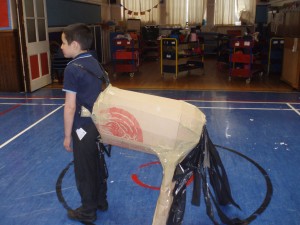 the Flora Stevenson centaur! How do you choose your favourite characters? Does having a favourite character in one book make you want to read more about them in another book? (Is that why series are so popular?) And when you’re writing a story, are you ever surprised at which character you end up liking the best?
|
| Feb 21 |
Filled under: Events, Maze Running, Novels, Readers, Research, Writing | by laridon |
I answer lots of questions about writing: questions from readers, questions from teachers, questions from journalists, even questions from publishers.
Usually when I’m answering questions at author events, I’m too busy thinking about my answers and trying to be both honest and interesting, while also trying not to fall off a stage or stand on the kids at the front, that I don’t really listen to my own answers. Sometimes afterwards I can’t even remember what the questions were, let alone what answers I gave, because it was all so fast and furious and exciting.
And once I’ve answered questions from journalists, I never read the articles or listen to the interviews. I just give them to a trusted family member or friend, and ask them to check I didn’t say anything really embarrassing.
But I’ve had to watch an interview recently – a rather beautiful interview filmed by my publishers for their website, with me standing in front of the maze which stars in the first chapters of Maze Running, and answering lots of questions about writing the First Aid series. I had to watch it to let Floris know I was happy with it before they made it public.
It was really interesting to see how I reacted to some of the questions. I wasn’t worried about standing on any kids (though there was a danger I might fall off the terrace into the maze!) and I knew the lovely Benedicte would let me have another go if I fluffed an answer, so this is probably about as relaxed as you’ll see me talking about writing.
And I found out a few things about myself as a writer.
Firstly, I found out that I’d be useless on a real quest (I said I’d take a pen and paper with me in case I had an idea for another book. So apparently I’d treat a real quest as a way of getting ideas to write a pretend quest. That would be quite annoying for everyone else on the quest…)
I also discovered that I am naturally polite to landscapes. I felt I had to say that my favourite location was Traquair just in case the maze was offended while I talking about it. It is a really good location, and perfect for the start of that book, but I’ve set books in caves and on cliffs, and those are pretty exciting to research and write about. But I didn’t like to mention that in the interview, in case the maze went in the huff.
I did look a little embarrassed about conning academics with questions about fish and seals when really I was researching mermaids and selkies. (Warning, professors – watch out for sneaky authors!
And you can tell that I really care about the characters. I talk about Yann, Helen, Sylvie, Lavender and even the Master as if they were real people. Which of course they are, in my head.
And probably the greatest truth about writing that I utter in the entire interview is one which I must remember when I’m auditioning those ideas for the next novel: “You can’t have a story until you have a baddie!”
But you can tell how relaxed I was at answering questions from someone I like and trust, because if you watch the whole interview you’ll catch me admitting to not getting it quite right in the first novel (though notice I try to blame my heroine rather than myself…)
I enjoy answering questions about writing because I sometimes discover new things about my own writing process (and occasionally I even remember afterwards!) But most importantly, when readers ask questions, I find out what you like in stories, so that’s what I go home to write! (I wonder if I can tell what my publishers would like me to write next, from the questions in this interview? Maybe I should watch it again…)
Anyway, have a look at the interview, and let me know if I said anything really daft! Perhaps you could consider what questions you would ask yourself about your own writing, and what you think you’d find out?
And has anyone else ever felt the need to be polite to a hedge?
|
| Dec 12 |
Filled under: Maze Running, Novels, Readers | by laridon |
When my publishers first mentioned a book trailer for Maze Running I was a bit worried – I thought I’d have to script it, or at the very least appear in it. But it’s been a very painless process: Floris Books wrote it, filmed it and edited it themselves, with no involvement from me at all. And now the Maze Running trailer is up on Youtube, I’m really pleased with it. I think it’s a combination of wonderfully simple and excitingly pacy. (Here it is…)
I’m a fan of trailers. When I go to the cinema, I always make sure I’m settled down in plenty of time to see the trailers, so I can enjoy a little taster of films I’ll probably never have time to go and see. And I’ll even admit to wasting a bit of writing time recently watching every available version of the Hobbit trailer online.
A film trailer is usually (not always, but usually) a good way to decide if you’ll enjoy the full film, because you get a sense of the content and the style of the film.
But is a trailer a good way to decide if you’ll like a book? If you like the look of the trailer, or the background music, or a voice-over, then you might decide to read the book, but none of those elements will appear in the book (which is simply words on a page, not pictures on a screen or music in an earphone.)
And if you don’t like the music or the camera angles, could the trailer put you off the book? And would that be daft, because the book trailer isn’t made up of bits of the book in the way that a film trailer is made up of bits of the film?
So is a trailer a useful way to judge a book?
Probably it’s no dafter a way to judge a book than by its cover, given that the cover artist often hasn’t even read the book! Or by its blurb, which isn’t usually written by the author.
Are any of these useful ways to pick a book? Or are they all just ways for a book to catch your eye, then the story inside must live up to the cover, blurb or trailer’s promise?
Are book trailers just another way for publishers and authors to try to give books a presence online (like Facebook, Twitter, and blogs like this…) and does all this (very time consuming!) online activity actually help readers choose books?
So what do you think of the current trend of trailers for books?
Have you ever gone out and bought a book simply because of a trailer?
What do you think of the Maze Running trailer?
And what other book trailers have you enjoyed?
|
| Nov 19 |
Filled under: Myths, legends, folklore, Picture Books, Readers, Research, Uncategorized, Writing | by laridon |
Retelling an old story which everyone already knows is a bit scary; retelling an old story almost no-one knows is even more of a responsibility.
My first retelling of a well-known fairy tale – Little Red Riding Hood – has just been published. When I was writing it, I had to decide which bits of the many versions of Little Red I would weave together. I did a lot of research, then chose the elements which were most vivid and which worked best in my voice. So I hope I’ve retold a story which you will recognise, but which will also surprise you. A journalist recently asked me how I had changed the story, what spin or twist I had put in, but that wasn’t what I was aiming to do with this retelling. Every major plot element comes from one of the older tales, though I have told the story in my own words, and I’ve tried to make a few of the things which never made sense to me (why doesn’t she realise it’s a wolf in the bed, not her granny, for goodness sake? Can’t she tell the difference?) seem more plausible (she sees more of the wolf each time she lets extra light into the room: opening the curtains, lighting the fire etc.)
But it’s a huge responsibility retelling a story like Little Red Riding Hood. Children already know it, and if you write something which differs from the version they know, they might think it’s wrong! (Which can prompt interesting discussions with kids about how traditional stories are passed on and changed.) Also, this book, with Celia Chauffrey’s gorgeous pictures, might over the years become some children’s very first experience of Red Riding Hood, so when they read other versions they might think my version is the right one and other versions are wrong… That’s a big and scary responsibility!
But I’m very glad that this story of a tricksy, talking, toothy, people-eating wolf is a story most children already know. Because if they didn’t, they’d probably find it far too scary and gory to enjoy it!
I’m now also retelling some stories which aren’t so well known: six animal tales from around the world (two already published, about a tortoise and a tiger, another four in the next couple of years, including a bear and a fox); a collection of Scottish folktales (coming out next summer, which contains stories I’ve never seen in other illustrated collections); and a collection of heroine stories from around the world (most of which are very obscure.) And that’s a completely different kind of responsibility.
Because I do change stories when I tell them out loud. I deliberately change them so they make sense in my head, so they work in my voice, so they are dramatic in the way that I like a story to grab and hold the attention of an audience. Therefore the story I tell is never exactly as it was when it was written down, a hundred, a thousand or four thousand years ago. And that story, the one I tell out loud, the one I’ve changed to become my story, is the one I write down. I’m always quite honest about that, but now these versions are being printed and published, available on paper for anyone to read, forever… that is a serious responsibility.
With Little Red Riding Hood, if I make a minor change, I know that kids will see another half dozen versions over the course of their reading lives, they will compare those different versions, realise there are many ways to tell a story and decide which is their favourite. But when they read my retellings of the untrustworthy Korean tiger or the Witch of Lochlann or Inanna tricking the god of wisdom, they might never see that story anywhere else. My version will be the only version they know. And that’s a really heavy responsibility.
But I’m not worrying too much about it. These are great stories, I’m writing them as well as I know how, I’m really excited about sharing them and I want you to enjoy reading them. Then if you want to study them more deeply by reading the ancient originals, I’m quite happy to point you in the right direction!
Here is the gorgeous front cover of LRRH, and I’ll update on you on the other retellings nearer the time!
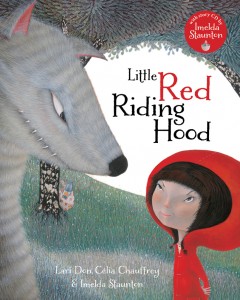 Little Red Riding Hood |
| Oct 31 |
Filled under: Maze Running, Novels | by laridon |
There’s a set of questions doing the rounds of authors’ blogs at the moment – the idea being that one author asks five other authors (authors whose work they like, and who they think might be The Next Big Thing) to answer the same questions the next week.
I was delighted to be asked by Roy Gill last week (here are his answers, about his fabby new book The Daemon Parallel) and you can find the authors I’m passing the torch onto at the bottom of the blog.
Here are the questions:
• What is the title of your next book?
It’s called Maze Running. Its full name is Maze Running And Other Magical Missions, because it’s part of a series which began with First Aid For Fairies And Other Fabled Beasts, so each subsequent book has a long and unwieldy title. But the book answers to Maze Running when you’re shouting it in for its tea!
• Where did the idea come from for the book?
It grew out of a quest I nearly wrote for Wolf Notes, the second book in the series, but which didn’t quite fit with that story. It was about Helen (my human heroine) and Lee (an untrustworthy faery warrior) going on a quest to find a token with magical healing properties. Then I thought – why not END the series with this quest, because the books are about a vet’s daughter who uses scientific and veterinary healing techniques to heal magical creatures. So I wondered – what if one of Helen’s friends is magically injured, so her rational human first aid won’t work, and they need to find magic to heal magic? Then the single quest turned into three simultaneous quests, as all of Helen’s friends desperately quest for the one object which will save their friend, but which might also – just to add to the tension – help the usual lurking baddie to take over the world. So a quest which wasn’t right for one book, ended up inspiring an entirely new book.
• What genre does your book fit into?
Scottish fantasy adventure, for 8 – 12 yr olds (if that’s a genre!)
• What actors would you choose to play the part of your characters in a movie rendition?
This is the question which worried me most when I agreed to do this blog post!
I’ve always loved the covers of these books, because the silhouettes of the centaur, the selkie, the faery etc, leave the readers lots of space to imagine the characters, to create their own unique film running in their head as they read. But if I picked a few actors’ names out of the air, and attached them to these characters, suddenly readers would see those famous faces imposed on the characters in their heads. And I think that would alter the relationship between the reader and the story. So, I’m not committing myself to this one!
• What is the one sentence synopsis of your book?
Searching Scotland for the magic to save your friend, and the courage to stop those who would use your quest to control the world, all by sunset on the Spring Equinox.
• Will your book be self-published or represented by an agency?
I am represented by the wonderful Fraser Ross Associates and these novels are published by the equally wonderful Floris Books.
• How long did it take you to write the first draft of the manuscript?
Just over six months, which is half as long as most of the novels in the series, because the story was so clear in my head when I started, and also because I really know the characters well by now.
• What other books would you compare this story to within your genre?
I wouldn’t dare compare anything I write to the books I love the most … but I know what I’m aiming for. I love the mix of myth and modern in Rick Riordan’s Percy Jackson and Heroes of Olympus books, and as a child I loved the Chrestomanci books by Diana Wynne Jones, which are amazing at creating worlds which are almost, but not quite, like our own.
• Who or what inspired you to write this book?
The readers who loved the other books in First Aid for Fairies series. And who – it turns out – are quite upset that Maze Running is the final book in the series. Sorry!
• What else about your book might pique the reader’s interest?
The real Scottish locations. I’ve used real places which have legends and magic attached to them, like the Eildon hills, the Sutors of Cromarty and the king-making hillfort of Dunadd. But if mythical geography isn’t your thing there are also some kickass baddies in Maze Running: minotaurs, dragons, uruisks and some very creepy women in red.
Here (in no particular order) are five other writers and illustrators I’d like to introduce you to, who are going to answer the same questions NEXT week, so please check back and see what they say about The Next Big Thing:
Lynne Rickards, who writes very funny and touching picture books, mostly about penguins and puffins! (She’s also a great artist herself, so her blog is always beautiful.)
Cate James, who is a wonderful illustrator of picture books, and also has the great responsibility of being the illustrator of my first collection of myths and legends (all my favourite Scottish stories) which comes out next year.
Joan Lennon, who writes the clever Slightly Jones Mysteries, and who kindly let me sit in on one of her school visits when I was an ‘about to be published author’ almost 5 years ago.
Helen Grant, who writes extremely spooky, action-packed teenage novels set mostly in Germany, which have a very fairy tale feel. But not the fluffy pink fairy tales, the deep dark forest Grimm fairy tales (which I much prefer.)
Caroline Dunford, who is a prolific writer of non-fiction, crime novels and plays, and still manages to be a huge support and source of advice for other writers too. She also has the most incredibly cool Twitter name: @verdandiweaves
And of course, if you want to read other writers’ answers NOW, you could go back to Roy’s blog, read his fascinating answers about his excellent book the Daemon Parallel and also investigate what the four other writers he tagged last week, are putting up this week. (I hope we all give different answers…)
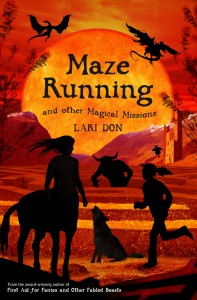
|
| Oct 04 |
Filled under: Events, Maze Running, Monsters (defeating!), Novels, Readers, Research, Uncategorized, Writing | by laridon |
I visited Traquair Maze again last week, filming an interview about Maze Running. I’ve been to the maze several times now, the first couple of times to research the novel, then another couple of times for press and publicity things (research is far more fun!) But this time, something had changed.
We came round the corner of the lovely old house, lugging cameras and tripods and copies of the book, and we walked into a
BEAR.
A bear. Just standing there. Ignoring us.
It took a minute to realise that it was a statue of a bear. There were two of them: one bear near the corner of the maze by the house, the other bear near the entrance of the maze. And they were obviously permanent residents – there was even a sign saying ‘do not lean on the bears.’ It’s probably ok to feed them, or tell them stories, though!
They were lovely bears. But they annoyed me, because they weren’t there when I researched the book! So when I described Helen running round the maze, or Sapphire landing between the house and the maze, I didn’t mention any bears. And now someone reading the book who knows the maze, or someone who visits the maze after reading the book, might say: ‘How came Helen never saw those big bears?’ or ‘Why didn’t that writer research the maze properly before she wrote this book?’
I did research it! And if the bears had been there when I first visited, Helen would undoubtedly have used them in some clever way to defeat the Master.
But the bears weren’t there last year. So they didn’t make it into the book, and now the book is already out of date, even though it was only published a couple of months ago.
Does it matter? Is it just one of the risks of using real life places, that they don’t stay the same? It’s happened to me before though…
When I first visited Dunvegan Castle to case the joint for the break-in during Wolf Notes, there was a ‘prisoner moaning’ sound effect in the dungeons which sounded like a monster howling, so I put that in my book. When I went back to do an event about Wolf Notes, they had changed their sound track and the moan wasn’t there any more. (So I read a different bit that day!)
These changes in a location can make me feel like the world is moving my goalposts without telling me. And every time it happens, I think, ‘oh no, I should never revisit locations!’
I never regret using real locations, though, because I want the fabled beasts to have their adventures in the same Scotland we live in!
But sometimes these new discoveries at locations can enhance the book, in a way which is almost magical.
I researched Smoo Cave for Storm Singing in the winter, so there were no boat tours to the inner caves (that didn’t affect my research, because all the action happened in the outer cave and the first cave, which you can see from the viewing platform.)
I went back the next summer, to read the quest in the cave to a group of kids in the cave, and I went on the boat trip too. When the tour guide dropped bread in the water of the dark cave, where I had imagined a giant eel snapping at Helen’s feet, suddenly the water was alive with fish, snapping at the bread. That was a spooky and shocking realisation that what I had imagined – predators under the water – wasn’t very far from the truth!
Locations change, of course they do. That’s bound to happen if I use real life places. Sometime they change in a way which makes my research a wee bit out of date, and sometimes they change in ways which make the adventures seem even more true!
And I didn’t really get too annoyed about unexpected bears. Especially when they were happy for me to read Maze Running to them…
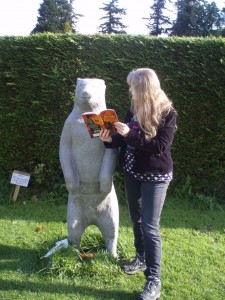 Reading Maze Running to a Bear 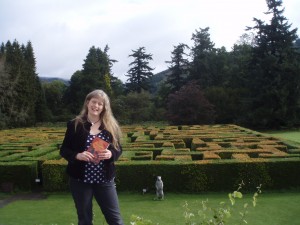 Unexpected bear, at Traquair |
| Sep 25 |
Filled under: Events, Picture Books, Readers, Writing | by laridon |
I’m often asked at author events whether my own children give me ideas or help me write my books.
And the answer is no, they don’t give me ideas (if they have good ideas, I hope they’ll write those ideas themselves!) but I often have ideas when I’m with them. In fact two of my picture books and all my novels were inspired in some way by my two girls.
They are hugely helpful in lots of other ways too. They read kids’ books, then recommend the ones they really like to me. (And they put some kids’ books down after just a few pages too, and seeing what books don’t grab them is just as useful to a writer…)
They are very useful at suggesting character names: they get credit for Roxburgh the selkie in Storm Singing, for example, and I brainstormed a few of the dragons in Maze Running with them too.
They let me read them early drafts of all my books, and reading out loud to them is a great way of gauging whether the book is working. Sometimes I scribble in the margin “this bit is boring” because I can see them losing interest. Then I ruthlessly edit that bit before it gets anywhere near paying readers!
As they are getting older, they have even started proof-reading my manuscripts on paper. My 9 year old read Maze Running with a red pen, and made some very helpful comments and criticisms.
But the main thing they do is show enthusiasm for stories. They get angry with me when I’m cruel to characters or put them in difficult situations. And if they get all excited about a story, then I know I’m on the right track.
When I was writing the animal tales for Barefoot many months ago, my younger daughter enjoyed my version of the tortoise story so much that she retold it on the living room carpet, as I was reading it out, with playmobil figures. So here is the wonderful tree, inside the circle of hungry animals (not all the animals are from Africa, to be fair, she did adapt it a bit!) The Tortoise’s Gift brought to life.
And when I’ve just burnt tea because I was scribbling down a ‘what if’ and I know I’ll be up past midnight trying to meet a deadline, then seeing my words inspire this sort of play makes it all worthwhile.
So yes, my kids do help. But not always in the way you’d think!
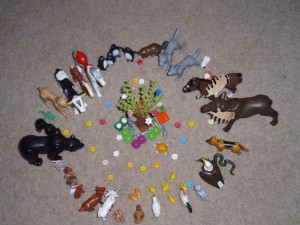 The Tortoise’s Gift, by the power of playmobil |
| Aug 31 |
Filled under: Picture Books, Research | by laridon |
Do you think children’s writers just sit at a desk and write? It’s much more fun and much dafter than that!
If you read my blog regularly, you’ll already know that children’s authors have to do some fairly strange things. But recently, my life has been getting even weirder. You can now find me on YouTube, flicking peas off the top of melting ice-cream, right across my own kitchen.
I spent a whole day with Chani and Benedicte from my publishers Floris, filming peas floating in glasses of orange juice and peas sitting on top of ice-cream… Why? Because they thought it would be fun for people to see me act out the story of Orange Juice Peas, my new picture book.
I’m used to reading the story out loud, but I’m usually in a classroom, library or theatre, so I don’t often have a fridge, a freezer and a bag of peas handy. But we thought that if we filmed it in my kitchen, we could do the whole thing for real. So we did. And it was very odd, and huge fun, and I suggest you have a look and let me know what you think!
But that may not be the oddest thing I’ve done while researching, writing or promoting my books. I’ve also:
– allowed a fairy to guide me through a maze;
– let the BBC get me lost in the very same maze;
– told a Viking legend in a cave;
– walked sunwise round a small hill in the Eildons looking for a magic door, on the same day that I’d been threatened by the Faery Queen on Twitter;
– shouted “Bottom!” loudly in the poshest, quietest bit of the Edinburgh Central Library;
– read from Wolf Notes in the gardens of a castle, rather than indoors, because the staff were a little nervous that the relevant chapters were about breaking in and stealing from their castle;
– phoned up a university to find a vet who could tell me how to heal an injured dragon;
– contacted a tropical fish society to ask about mermaids’ tails;
– tried out some exotic herbs and spices to find out what a witch would use to flavour the children she was going to eat;
– clambered along a clifftop in a howling gale;
– timed a frond of bracken travelling down seven waterfalls, in the Pentlands, on Christmas Eve;
– waggled my bottom at children on a regular basis, which may be why many infants now call me The Big Bottom Lady (because of the book title, obviously, not the size of my bottom!)
– learnt how to read (some) cuneiform writing, and invented my own Sumerian monsters;
– run down the same hill as Tam O’Shanter, like I was being chased by witches, when in fact I was being watched by puzzled American tourists.
Those are some of the daft and dangerous things I’ve done so far as a writer. I wonder what I’ll do now, to research my next book?
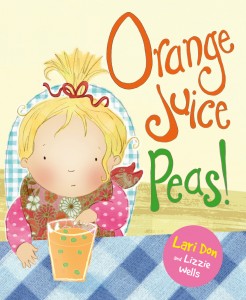
|
| Aug 22 |
Filled under: Book festivals, Bookshops, Events, Heroines and heroes, Maze Running, Novels, Readers, Writing | by laridon |
At the Edinburgh Book Festival earlier this week, I was sitting at a signing table looking at a long line of First Aid For Fairies fans (I knew they were fans, because most of them were cuddling a stack of slightly dog-eared books) and I had to think of something personal, interesting and appropriate to write in each book.
Because Maze Running is the last of the series, I asked most of the readers “Who’s your favourite character?” so that I could write in their book: “Thanks for coming on x’s last adventure.”
I’ve been asking that question in all the events I’ve done this summer, and I’ve been surprised to discover that pretty much every character has fans. In a line of readers there will almost certainly be Helen fans, Yann fans, Sapphire fans, Rona fans, Lavender fans, Catesby fans… There might be fewer Sylvie, Lee, Serena and Tangaroa fans, because they don’t appear in as many books. But even so, I think almost every character in the series is somebody’s favourite. At the Maze Running launch, I even met a boy whose favourite character was the Master of the Maze!
And I’ve met, or seen pictures of, children dressed as various First Aid For Fairies characters for World Book Day (I’ve met Helen, Lee, Lavender and Rona, but I wonder if there have been any others? Any phoenixes? Any centaurs? In fact, I hereby promise to send a free signed book to the first person who can prove they’ve successfully dressed up as Yann!)
I have my own favourite characters too. But I wonder whether I like my characters for the same reasons readers do?
Do some readers like Lavender or Rona because they like the idea of being a fairy or a selkie? Do some readers like Sapphire because all dragons are cool? (As well being as fiery hot…) So now my signing queues could get even longer, because I might start asking not just: “Who’s your favourite character?” but also: “Why?”
As a writer, I like my characters for lots of different reasons. For example, a particular character might be very useful when I’m writing the story: Sapphire is incredibly handy as transport, Yann is great for kicking doors in, Lavender is very easy to injure (sorry), Sylvie can be relied on to disagree with pretty much anyone. And there wouldn’t be a First Aid for Fairies series at all without Helen to be our guide in that world, or all those nasty baddies making the adventures necessary.
But I don’t just use my characters to push the story along, I enjoy their company too. So my truly favourite characters are the ones whose voices I can hear in my head, who seem to come alive as I write and who surprise me by doing things I don’t expect. For that reason, Yann is my absolute favourite because he argues with me all the time (I can sometimes actually hear him shout at me) and I’m also very fond of Lee, because I never quite trust (or understand) his motives or indeed his world, which is a very interesting position for a writer. And outside the First Aid For Fairies series, I love Emmie in Rocking Horse War, who changed that entire story by putting her hands on her hips and giving me a cheeky smile.
So, who are your favourite fabled beast characters, and why? And do you think writers and readers like characters for different reasons?
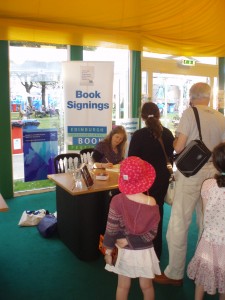 Maze Running signing queue at Edinburgh Book Festival 2012 |
|
|

I’m children’s writer, and I write this blog mainly for children – readers, young writers, school classes, book groups etc, who want to understand how a writer writes. Everyone else welcome too though! And please do comment if you have any questions, or want me to blog about anything specific.
|









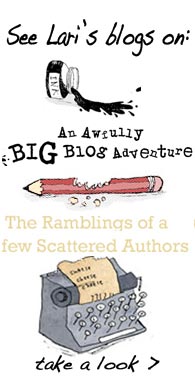
Recent Comments